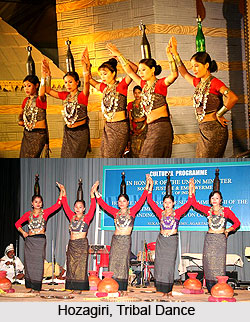 Hozagiri Dance is one of the most colourful dances which is practised by the tribal community of `Reangs` residing in the north-eastern Indian state of Tripura and is distinct due to its unique nature. Hozagiri dancers avoid the movement of the upper portion of their bodies while there exists a graceful movement of their bodies downwards, starting from their waists, which impart a beautiful appeal to the dance. Performed in a group of four or six, the trick of this dance-form is the capability of balancing. The dancers stand over an earthenware pitcher, balancing a bottle on their heads which has a lighted lamp while the dancers grab the attention of the audience through their beautiful movements. The viewers are spellbound particularly when the dancers sway the lower portions of their bodies during the dance.
Hozagiri Dance is one of the most colourful dances which is practised by the tribal community of `Reangs` residing in the north-eastern Indian state of Tripura and is distinct due to its unique nature. Hozagiri dancers avoid the movement of the upper portion of their bodies while there exists a graceful movement of their bodies downwards, starting from their waists, which impart a beautiful appeal to the dance. Performed in a group of four or six, the trick of this dance-form is the capability of balancing. The dancers stand over an earthenware pitcher, balancing a bottle on their heads which has a lighted lamp while the dancers grab the attention of the audience through their beautiful movements. The viewers are spellbound particularly when the dancers sway the lower portions of their bodies during the dance.
The dancers of Hozagiri twist the lower parts of their bodies, adhering to a specific rhythm, without bothering the lighted lamp and also the bottle. Generally, Hozagiri Dance is performed during the month of April. Hozagiri Dance is displayed during new harvests and for worshipping the Goddess of Wealth, Lakshmi and is basically a female dance. Dance experts have linked Hozagiri Dance to some famous Indian classical dances including Manipuri and Kuchipudi. They are of the view that this exclusive dance-form can compete with all the classical dances practised in the nation.
Some musical instruments like Flute which is made from Bamboo and Bamboo cymbals and also Khamb are employed by musicians for accompanying Hozagiri Dance. The womenfolk of Reang tribes are clad in `Rea` and `Pachra` costumes for the performance of Hozagiri Dance. They also wear coins ring which embellish the upper part of their bodies and wear rings of coin in their ears. The dancers are also fond of wearing flowers as jewels, thereby exuding a sweet, floral fragrance as they dance. While the women dance, the men sing the lyrics of the accompanying song while playing the `Sumui` and other instruments. Sometimes the women also join the menfolk in participating in the chorus team, in singing group. The lyric are quite simple, especially when compared to the creative dance.



















